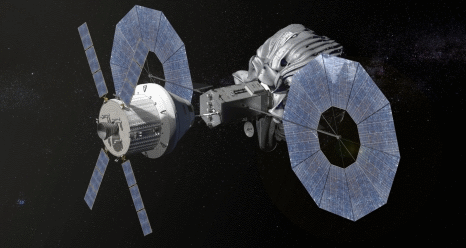
Just a few days ago, NASA sparked our space imaginations again when they released new photos and video animations of the planned missions to "find, capture, redirect, and study a near-Earth asteroid." The video [watch below] outlines the mission from lift-off to return landing, giving us front row seats to the Orion spacecraft leaving Earth, the crew's operations, and their trip to a 'captured' asteroid. There are even scenes depicting astronauts performing spacewalk activities and collecting surface samples.
"Part of President Obama's FY 2014 budget request for NASA, the asteroid initiative capitalizes on activities across the agency's human exploration, space technology and science programs," says Rachel Kraft from Headquarters. "NASA is enhancing its ongoing efforts to identify and characterize near-Earth objects for scientific investigation, and to find potentially hazardous asteroids and targets appropriate for capture and exploration."
 This conceptual image shows NASA's Orion spacecraft approaching the robotic asteroid capture vehicle. The trip from Earth to the captured asteroid will take Orion and its two-person crew an estimated nine days. Image Credit: NASA
This conceptual image shows NASA's Orion spacecraft approaching the robotic asteroid capture vehicle. The trip from Earth to the captured asteroid will take Orion and its two-person crew an estimated nine days. Image Credit: NASASo, what exactly are these plans and why are they important? According to the press releases, the FY 2014 budget proposal allows for a mission which will capture a small near-Earth asteroid robotically. Once this portion goes successfully, it will then be redirected to a safe and stable orbit in the Earth-Moon system. If this segment of the mission is also successful, astronauts will then be able to physically study and sample the asteroid. While there isn't a potential asteroid threat at this time, the possibility is very real. Astronomers have pinpointed a huge portion of larger near-Earth asteroids, but only about 1% of the smaller - yet equally dangerous - rocky travelers have been documented. We need to know that we human beings can pull together as a team and successfully redirect an asteroid, be it for scientific or life-saving reasons.
"NASA already is working to find asteroids that might be a threat to our planet, and while we have found 95 percent of the large asteroids near the Earth's orbit, we need to find all those that might be a threat to Earth," said NASA Deputy Administrator Lori Garver. "This Grand Challenge is focused on detecting and characterizing asteroids and learning how to deal with potential threats. We will also harness public engagement, open innovation and citizen science to help solve this global problem."
Next year should be an exciting one for furthering the asteroid initiative as engineers begin to work out the details of the upcoming mission. However, they aren't the only ones. NASA is also considering ideas from the public as well as scientists and engineers from around the world. The asteroid program involves many scientific disciplines, such as advanced solar electric propulsion as a viable power source. Ideas like this could mean expanded possibilities for both the spacecraft and those planning its operations. The Orion spacecraft and the Space Launch System rocket will benefit, as well as new technology.
Just weeks ago, NASA compiled the work of agency leaders from across the country to review the asteroid mission's formulation. This gave new insights into a myriad of concepts and alternative proposals for each segment of the mission - from programming angles to technical advice. Thanks to industrial venues, educational institutions and the public, NASA has currently more than 400 responses to their request for ideas. From September 30 to October 2, they will host a technical workshop at the Lunar and Planetary Institution in Houston to discuss these concepts and their potential to be added to the mission statement. Be on the lookout as virtual participation becomes available to the public very soon!
Tammy is a professional astronomy author, President Emeritus of Warren Rupp Observatory and retired Astronomical League Executive Secretary. She has received a vast number of astronomy achievement and observing awards, including the Great Lakes Astronomy Achievement Award, RG Wright Service Award and the first woman astronomer to achieve Comet Hunter's Gold Status.















